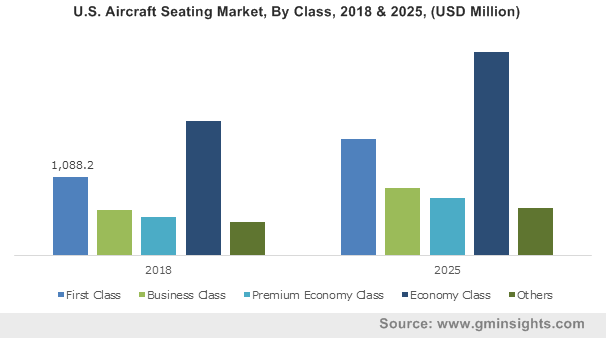Aircraft seating market to procure extensive proceeds from the economy class segment, innovative advancements brought forth by airline companies to augment the industry growth
Publisher : Fractovia | Published Date : April 2019Request Sample
With air passenger traffic surging at an exceptional pace by the day, aircraft seating market is most likely to register impressive growth trends in the forthcoming years. As comfort and luxury take precedence for the masses, airliners are working to improve air travel experience with comfortable and economic aircraft seats. Airline companies are now considering the ergonomics of cabin furnishings for customer comfort, while investing in technology upgrades, aircraft components and MRO, which would undeniably help augment the commercialization graph of aircraft seating industry.
U.S. Aircraft Seating Market, By Class, 2018 & 2025, (USD Million)

Several airline companies are modifying aircraft interiors including aircraft seats by pouring in substantial investments. Say for example, Australia’s budget airline company Jetstar, a couple of years back, made it to the headlines for having added an extra row of seats to cut off costs and ensure a low fare with great customer experience. The same year also witnessed Qatar Airways introducing Qsuites on its selected aircrafts. This business class seat range is unrivaled in terms of privacy, space, style and storage. As prominent airliners incorporate the latest technologies in their seat designs, aircraft seating industry is bound to depict an upsurge in terms of valuation.
Innovations in economy class, a while ago, were rather scarce, however, the demand for efficient seats for the economy class has led to the launch of a spate of unique designs. Airline companies are giving equal attention to economy class seats now for improved customer experience. Many companies have apparently collaborated for developing comfortable economy class seats while offering low air fares.
As a matter of fact, estimates claim that the economy class dominated aircraft seating market in 2018 on account of the requirement for a larger number of seats in airlines in order to accommodate the ever-expanding pool of passengers. These seats also come with features such as magnetic meal tray, automatic control of seat temperature, and extended headrest wings. Driven by the availability of a large number of flight routes, low air fares, and the need to ensure enhanced travel experience, aircraft seating industry is likely to accrue substantial proceeds from the economy class.
Elaborating yet another instance depicting the intensity of the competitive scenario in the aircraft seating market, earlier this year, Mirus Aircraft Seating collaborated with TUI Group to retrofit a number of Hawk seats in several airplanes operated by TUI Group in the Netherlands, the U.K. and Belgium. The Hawk seats by Mirus for TUI have been optimized for flights of up to 12 hours. The prevalence of collaborations such as the aforementioned is certain to add impetus to the growth graph of the overall aircraft seating industry.
Bringing about highly innovations has emerged to be a key growth strategy for industry contenders. Say for example, recently, Safran Seats unveiled Versa, a new generation of high-end business class seats at the Aircraft Interiors Exhibition. These newly designed seats offer space and weight optimization and can address an extensive range of airlines requirements efficiently. These are also equipped with wireless charging and audio, wider screens, new control systems, advanced lighting etc. It thus goes without saying that the demand for innovative, customized, and highly comfortable seats will drive the revenue graph of the global aircraft seating market.
It is being speculated that collaborations and bringing about novel products are bound to remain the go-to tactics for market players. Most of the leading industry participants are continuously making efforts to bring about advancements in existing seat designs to ensure customer comfort, which would eventually drive aircraft seating market. As per estimates, the global aircraft seating industry size may exceed $18 billion by the year 2025.